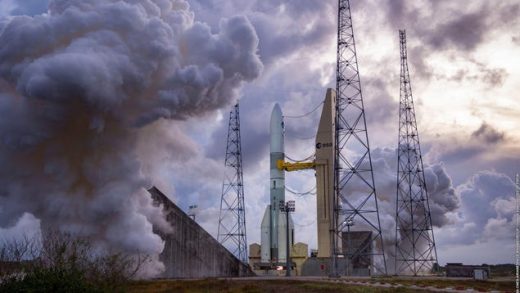Bruce Balick penned an urgent letter to his research partner on the other side of the country. He feared other radio astronomers were close on their heels, including one by the name of Fred Lo.
“We’d better publish fast if we want to beat him into print,” Balick wrote to Robert L. Brown, his collaborator, in the spring of 1974.
Having just received his doctorate degree from Cornell University three years earlier, Balick was young, ambitious, and eager to let the world know what they had found in the sky on a clear, dry February day. Competition could perhaps come from the side, too. Balick observed naturally occurring radiowaves from objects in deep space. But astronomers who study the sky at infrared wavelengths were sniffing around the same cosmic target, he wrote.
Balick and Brown did eventually win the race, receiving the credit for Sagittarius A*, pronounced “Sagittarius A-star,” the supermassive black hole found at the center of the Milky Way. They published their discovery the same year in the Astrophysical Journal in December 1974.
It was thrilling, Balick recalls. They had just peered 26,000 light-years into deep space and found the very soul of the galaxy. Little did he know that some 50 years later, he’d be staring at its face. On May 12, 2022, the international Event Horizon Telescope group released the first-ever photo of Sagittarius A* to the world, a dark spot with a fuzzy ring of red-orange light.
Behold the Milky Way’s supermassive black hole in first-ever photo
-
Astronomers see first supermassive black hole as it’s growing up
-
Black holes, ranked
-
What’s actually going on in that cryptic black hole photo?
-
Mesmerizing image of black hole reveals magnetic field
Tweet may have been deleted
Black holes are some of the most elusive things in outer space. The most common kind, called a stellar black hole, is often thought to be the result of a star larger than the sun dying in a supernova explosion. The star’s material collapses onto itself, condensing into a relatively tiny area.
But how supermassive black holes, millions to billions of times more massive than the sun, form is more mysterious than typical stellar black holes. Many astrophysicists and cosmologists believe these behemoths lurk at the center of virtually all galaxies. Recent Hubble Space Telescope observations have bolstered the theory that supermassive black holes get their start in the dusty cores of starburst galaxies, where new stars are rapidly churned out, but scientists are still investigating.
“We love our black hole.”
Black holes don’t have surfaces like planets. Instead, they have a boundary called an “event horizon,” a point of no return. If anything comes too close, it will fall in, never to escape the hole’s gravitational pull.
The image of Sagittarius A, or Sgr A* for short, is a masterful achievement, the second time scientists have overcome the barrier of invisibility to glimpse a black hole. Scientists say it offers powerful confirmation that supermassive black holes are indeed real.
The feat took years of work, involving 300 scientists at 80 institutions. Black holes are by definition unseeable — light can’t escape them. But Sgr A* revealed itself in the form of a black shadow surrounded by the brilliant glow of gas and dust.
Tweet may have been deleted
For most people, the snapshot was their first introduction to the eerie supermassive black hole in their galactic home. To radio astronomers, Sgr A* is an old friend, a deep space enigma they’ve tried to wrap their brains around for decades.
“We love our black hole,” said Feryal Özel, a professor of astronomy and physics from the University of Arizona, who helped release the groundbreaking new photo at a news conference in Washington, D.C.
The race to discovery
Half a century ago, Balick and Brown and another team were neck and neck in detecting the black hole, but for different reasons. They were all vying for time on the National Radio Astronomy Observatory’s Green Bank interferometry system in the West Virginia mountains, which linked three radio dishes and an antenna 20 miles away to simulate a larger telescope. The expansion of the antenna in Huntersville, W.V., was a giant leap forward in technology, enhancing image resolution tenfold.
Dennis Downes and W. “Miller” Goss, another pair of astronomers, submitted a proposal to look for potential remnants of a quasar or supernovas in Sagittarius A, an area in the constellation Sagittarius. Due to work and travel conflicts, Downes and Goss never made the journey from Europe to West Virginia in the fall of 1973, a few months before Balick and Brown’s turn.
Balick and Brown, who ventured from Charlottesville, Virginia, to Green Bank, were looking for something entirely different — star-formation regions near the center of the galaxy. They had observed Sagittarius B2, a cloud of gas and dust near the center, but didn’t find bright stars.

Credit: NRAO / AUI/NSF
“Just for the hell of it, we thought we would point the antennas at the real galactic center, Sagittarius A,” Balick told Mashable recently from his home in Washington state. “You could see a very strong signal, one that was far stronger than anything we might have had any right to expect.”
Filled with adrenaline, he told David Hogg, the Green Bank site director, about the signal. That’s when Hogg, who was responsible for scheduling observation time, realized they had used a configuration and radio wavelengths that another research team (Goss and Downes) had wanted to pursue. Such conflicts could ignite controversy and competition, so Hogg asked Balick and Brown to wait while he tried to communicate with the other team, according to recollections published many years later. Perhaps they could work together or get some credit in the paper.
“Just for the hell of it, we thought we would point the antennas at the real galactic center, Sagittarius A.”
For the next three months, Balick, who had moved to Santa Cruz, California, for a job, and Brown, who remained in Virginia, worked 2,800 miles apart, corresponding by mail, to complete the calibration of the data and develop explanations for their findings.
Goss, who lives in New Mexico today and is retired, said he never held a grudge against his colleagues for discovering the supermassive black hole. For Goss, who knew early on that he would spend his career studying the galactic center, it was just exciting to know that Sgr A* existed.
“We thought, ‘Well, you know, they did it.’ We might have done it, but they were ahead of us slightly, which was fair enough,” he said. “There was never any ill will at all.”

Credit: Woodruff T. Sullivan III collection / NRAO / AUI/NSF
Proof black holes are real
The idea of black holes had been around for a long time as a mathematical solution to a physics problem, but it wasn’t entirely accepted science. Even Albert Einstein, whose theory of general relativity predicted their existence about 60 years earlier, had his doubts.
Back in 1974, the year of Balick and Brown’s discovery, British astronomer Sir Martin Rees proposed that supermassive black holes could live at the centers of some galaxies, but that was still considered radical thinking.
“Everyone kind of assumed that they just evaporate,” Michael Johnson, from the Harvard Smithsonian Center for Astrophysics, said at the Event Horizon Telescope news conference. “It doesn’t feel like they could exist in nature, and I think that sort of persists for us. You’re always waiting for something to step in and say, ‘OK, of course black holes are just science fiction, there’s something else there.'”
So the question for Balick and Brown, 50 years before the photographic proof, was what were they going to publish? How far could they stick their necks out?
Given how controversial black holes were at the time, the scientists came just short of calling Sagittarius A* a black hole, Balick said.
The six-page paper never references the term. Instead, the two called the black hole a physical structure that “defines the galactic center.”

Credit: NRAO / AUI/NSF
“If this turned out not to be a black hole, my career would tank. So there was a political decision being made here, not a scientific one, on what we should say,” Balick said.
At the age of about 30, he was not willing to stake his career on such a brazen claim.
“I was trying to make sure I passed the laugh test,” he said.
Eight years later, Brown coined the name “Sagittarius A*” for the black hole. He used the asterisk to distinguish the compact radio source from other elements of the galactic center. Jotting down ideas on a yellow notepad one morning, he thought about his doctorate dissertation. In atomic physics, scientists indicate high energy states with the symbol. By analogy, he thought using the “star” would convey the small, bright radio source.
The name stuck.
“I was trying to make sure I passed the laugh test.”
While Brown and Goss continued their research on the galactic center over the years, Balick’s interests took him elsewhere. He developed an expertise in planetary nebulas, the clouds of gas and dust jettisoned by dying stars.
Today, some of the scientists who researched Sagittarius A in the 1970s are gone. Lo and Brown have since died.
Tweet may have been deleted
Balick, a retired University of Washington professor, didn’t get a sneak peek of the photograph of his discovery. Instead, the octogenarian waited for the Event Horizon Telescope’s announcement to finally meet his elusive friend, just before hitting the road to visit his grandchildren. It was as if he were an ordinary member of the general public.
Sgr A*’s mug was just as Balick imagined: a dead ringer for the first black hole photo released in 2019. Its predecessor was a much larger supermassive black hole at the center of the Messier 87 galaxy.
“If it looked much different, then general relativity would need a major makeover,” he said.
He only wished Brown were alive to see it, too.

Credit: NRAO / AUI / NSF
The rabid attention for Sgr A* brought back memories for Goss but still no feelings of jealousy, he said.
Arriving at this point required the efforts of a whole community of scientists. Donald Lynden-Bell, for one, is “an unsung hero,” he said, having brought about a theoretical understanding of compact radio sources at the centers of galaxies, quasars, and black holes. And the dozen or so electrical and mechanical engineers who built the Green Bank radio telescope array deserve recognition, too.
“It’s an incredible achievement of many, many people,” he said. “Those of us who ended up doing the observations were just standing on their shoulders.”
Source : He found a Milky Way black hole 50 years ago, and finally got to see it












